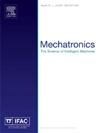FPAA-based control of a high-speed flexure-guided AFM nanopositioner
IF 3.1
3区 计算机科学
Q2 AUTOMATION & CONTROL SYSTEMS
引用次数: 0
Abstract
This paper presents the design, characterization, and control of a novel flexure-guided piezoelectrically actuated atomic force microscope (AFM) nanopositioner. The planar scanner achieves a scan range of in both X- and Y-directions with a first resonance frequency above . Lateral displacements are measured using an interferometer sensor. A signal-transformation-based control technique and a signal pre-shaping method are explored to enhance raster scanning. An integral resonant controller (IRC) increases closed-loop bandwidth by damping the scanner’s fast axis dominant mode. Since the high-bandwidth system requires a high sampling rate, the IRC scheme is implemented using a field-programmable analog array (FPAA). The tracking performance is improved by a double integrator. The effectiveness of the signal transformation approach (STA) with the pre-shaping method in the closed-loop system is investigated. Tracking errors at frequencies from to maintained RMS values below . Results demonstrate the technique’s success, achieving rapid time-lapse AFM imaging at 10 frames per second over a scan area.
基于 FPAA 的高速挠性制导 AFM 纳米定位器控制技术
本文介绍了一种新型挠性导向压电致动原子力显微镜(AFM)纳米定位器的设计、表征和控制。该平面扫描器在 X 和 Y 方向的扫描范围均达到 5.8 μm,第一共振频率高于 15kHz。横向位移通过干涉仪传感器测量。探索了一种基于信号变换的控制技术和一种信号预整形方法,以增强光栅扫描能力。积分谐振控制器(IRC)通过抑制扫描仪的快轴主导模式来增加闭环带宽。由于高带宽系统需要较高的采样率,因此采用了现场可编程模拟阵列(FPAA)来实现 IRC 方案。双积分器提高了跟踪性能。研究了信号变换方法(STA)与预整形方法在闭环系统中的有效性。频率从 10Hz 到 300Hz 的跟踪误差均方根值保持在 50nm 以下。结果表明该技术非常成功,在 2μm×2μm 的扫描区域内实现了每秒 10 帧的快速延时原子力显微镜成像。
本文章由计算机程序翻译,如有差异,请以英文原文为准。
求助全文
约1分钟内获得全文
求助全文
来源期刊

Mechatronics
工程技术-工程:电子与电气
CiteScore
5.90
自引率
9.10%
发文量
0
审稿时长
109 days
期刊介绍:
Mechatronics is the synergistic combination of precision mechanical engineering, electronic control and systems thinking in the design of products and manufacturing processes. It relates to the design of systems, devices and products aimed at achieving an optimal balance between basic mechanical structure and its overall control. The purpose of this journal is to provide rapid publication of topical papers featuring practical developments in mechatronics. It will cover a wide range of application areas including consumer product design, instrumentation, manufacturing methods, computer integration and process and device control, and will attract a readership from across the industrial and academic research spectrum. Particular importance will be attached to aspects of innovation in mechatronics design philosophy which illustrate the benefits obtainable by an a priori integration of functionality with embedded microprocessor control. A major item will be the design of machines, devices and systems possessing a degree of computer based intelligence. The journal seeks to publish research progress in this field with an emphasis on the applied rather than the theoretical. It will also serve the dual role of bringing greater recognition to this important area of engineering.
 求助内容:
求助内容: 应助结果提醒方式:
应助结果提醒方式:


